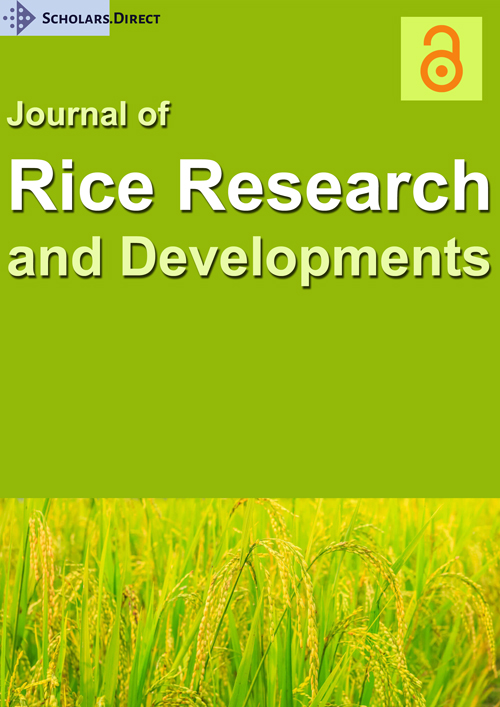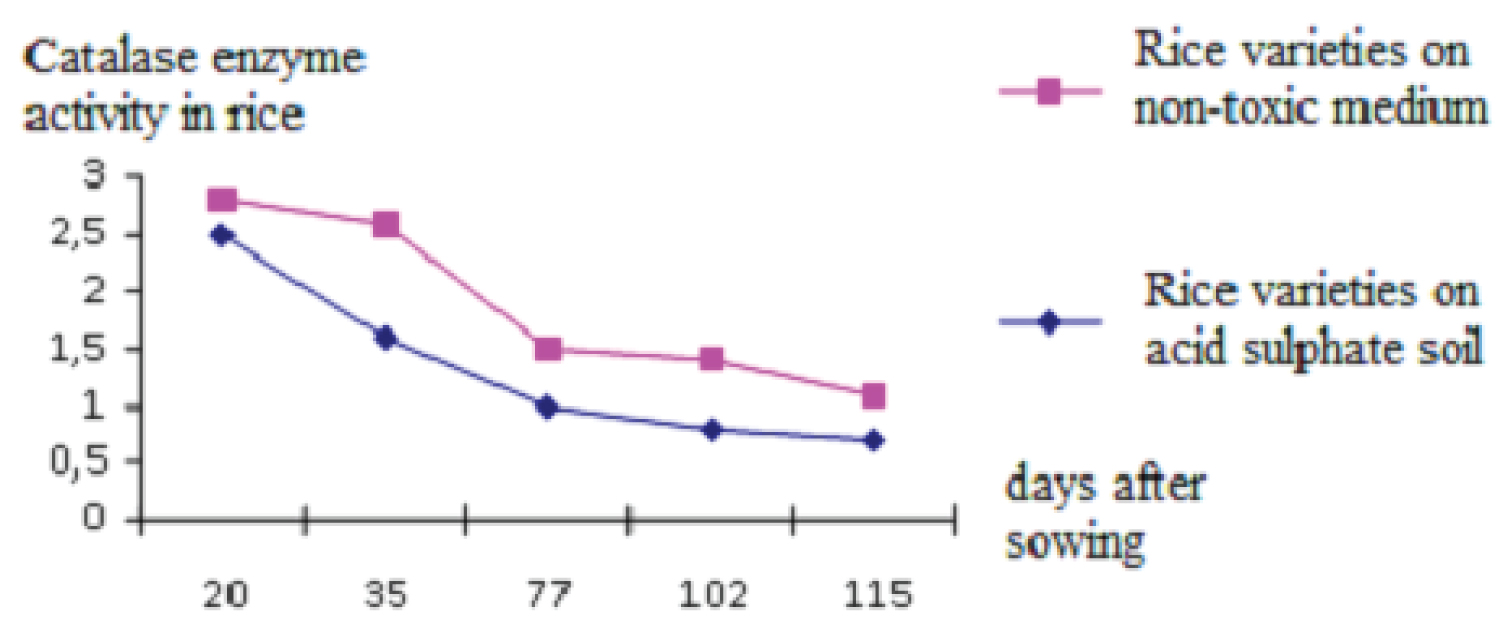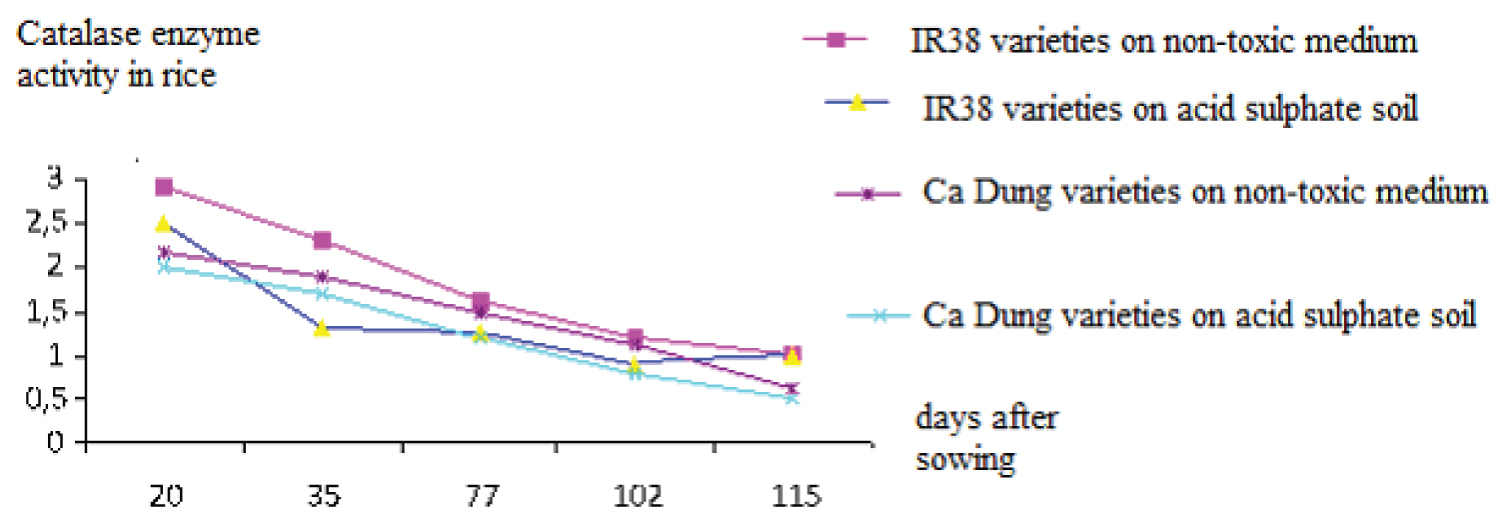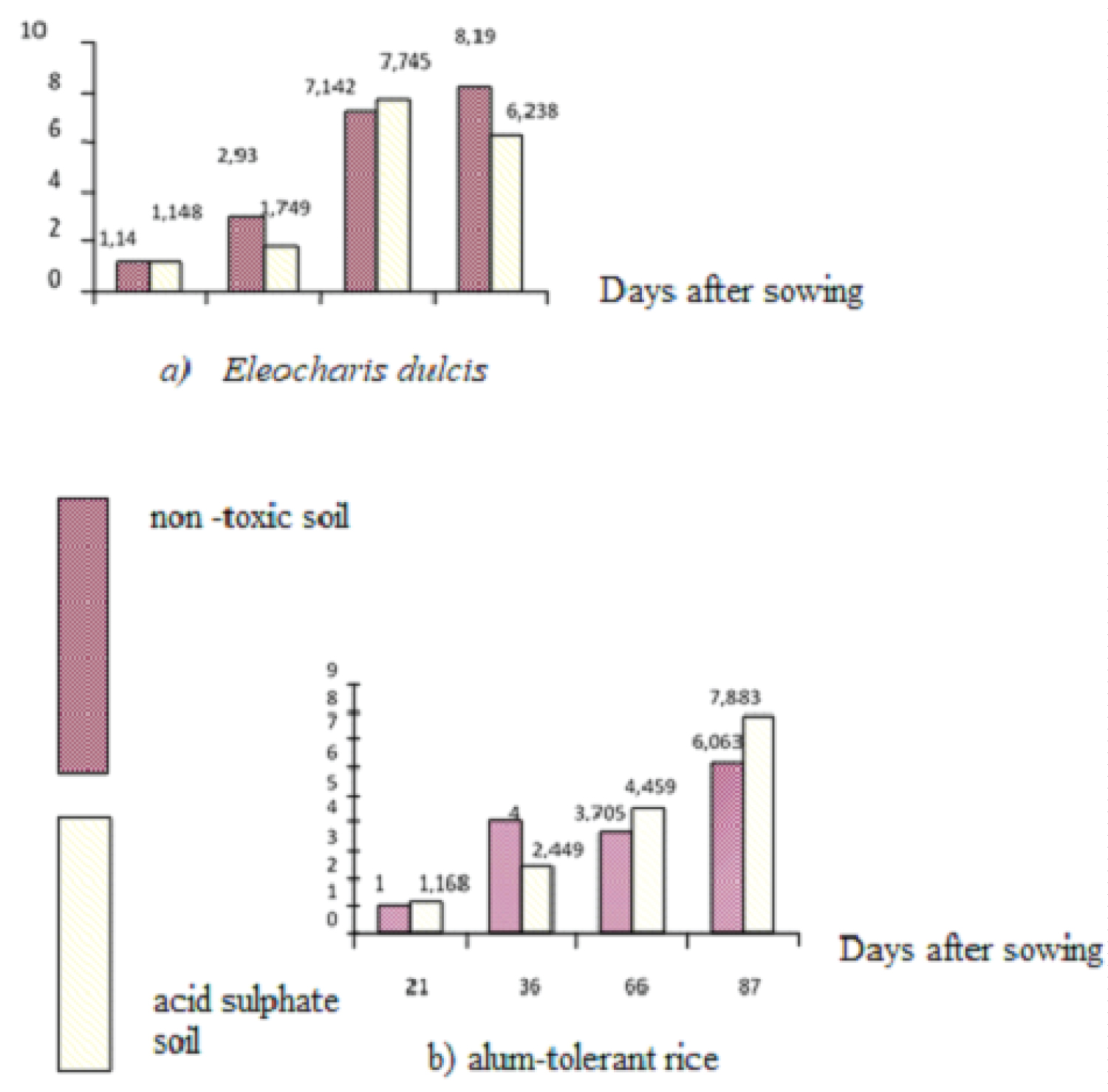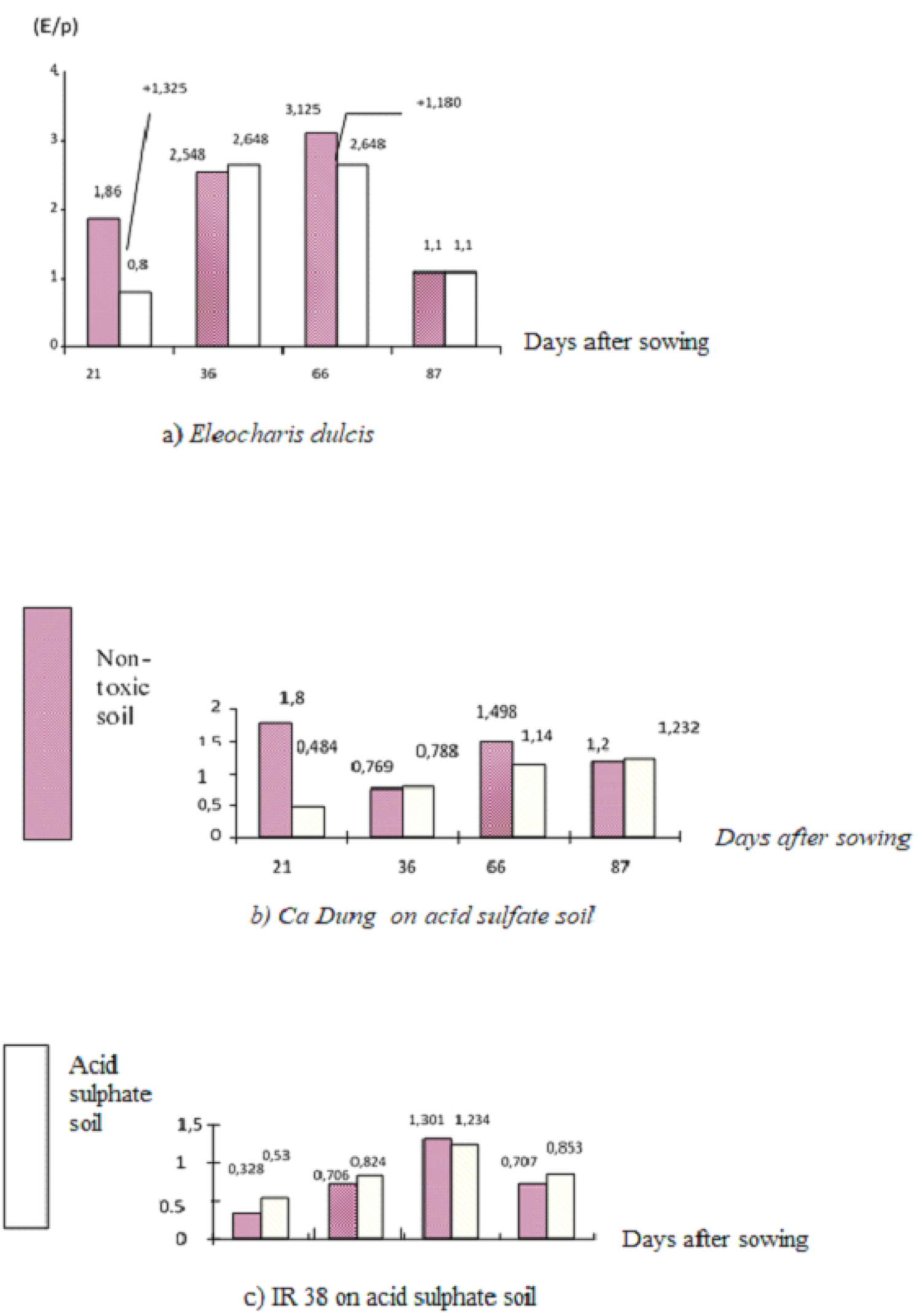The Poison-Resistant Nature of Toxicity Tolerant Rice Variety in Acid Sulphate Soil, Mekong Delta, Vietnam
Abstract
Assessing the resistance, determining the nature of the resistance of the rice plant through the activity of three enzymes in rice: Catalase, Peroxydase and Phosphatase in the leaves of rice plants (the most active leaves of rice) rice plants) [1]. In addition, consider the role of Phosphatase in the fluctuations and the ability to accumulate P2O5 in soil and plants to see its role in rice's poison resistance in acid sulphate soil [2]. In other hand, Results shows that- High concentrations of toxins in the soil environment strongly inhibited the activity of Phosphatase enzymes in the roots, in the indicator leaves, and especially for rice, especially for plants that are less resistant to poisoning. But, Phosphatase enzyme in leaves has the effect on the providing energy for the plants to recover from poisoning. The activity of this enzyme is inversely correlated with the content of Al3+ in soil and Al3+ in plants. This proves that the antagonism between enzymes and toxins is evident, especially with Al3+ toxins. In other side, has highly toxic in the acid sulphate soil environment inhibits enzyme activity Peroxydase in rice roots. Under these conditions, peroxydase in the root plays a small role in helping the plant recover.
Keywords
Toxic-resistant rice variety, Acid sulphate soil toxicity, Catalase, Phosphatase, Peroxydase in rice leaves, Acid sulphate soil
Introduction
Research of Le Huy Ba, et al. carry-out by [1-3] a series of experiments including: Step 1, Group testing of rice varieties including 15 varieties; In step 2, experiment comparing varieties to select alum tolerant varieties. Step 3, After identifying alum-tolerant varieties: Ca Dung variety (local) strong resistance to toxicity. Oppositely, IR38 variety is weakly to toxicity resistant. On other hand, they have found that, the toxic ions in acid sulphate soil environment (ex: Al 3 , Fe 2+ Fe 3+ and SO 4 2- ) there are coplicatly dynamics [1-4].
At this point, the new question that needs to be answered is the effect of toxins on the enzymes in plants. and vice versa, the role of the enzyme has no role to resist poison (how effect on this activity of enzimes in rice leaves). That means, what role of this enzyme to help rice plant to resistant influence of the toxicity. So that, we carry out some experiences ( in vitro, in green house, and in the yield experiment together with the practical survei).
Materials and Research Methods
Material
Whole acid sulphate soil (not disturbed by cultivation): Heavy alkaline soil with pH = 3.6-4.1; Al 3+ = 500-800 ppm, although the plants do not die but the toxicity is also very heavy, from which people choose resistant alum varieties.
Vietnamese rice varieties
-Select a selection of 15 new rice varieties including new varieties (IR38) and local varieties (Ca Dung)
- Compare and select toxity-tolerant varieties: Including good alum-tolerant rice varieties, weak alum-resistant rice varieties (rice varieties living on alum soil during the research process).
-The indicator tree is also a control plant: Elocharis Dulcis: Take normal growing plants, transplant into pots with alum soil.
- With the control variant of soil: Neutral alluvial soil (Tien river) is not alum or toxic.
So we have 2 control variant: With plants: Good alum-tolerant rice transplantation compared to poor alum-resistant rice and compared with indicator plants.
The toxicity and tolerance test of rice increased the toxicity levels (Fe 2+ , Al 3+ , SO 4 2- content increased gradually compared to the control (alluvial soil: non-toxic).
Experimental arrangement in pots placed in a greenhouse
- Arrangement in pots (diameter r = 30 cm, height: 50 cm, porcelain and porcelain materials), put in greenhouses (Poly Etylen)
- Experiment with 5 treatments, 4 replications, sequentially according to latin cell, the level of toxicity: Increasing, with treatments:
- With Al 3+
Al 3+ = 0 ppm, 2. Al 3+ = 135 ppm, 3. Al 3+ = 500, 4. Al 3+ = 800 ppm and 5. Al 3+ = 1000 ppm,
- With Fe 2+ :
Fe 2+ = 0 ppm, 2. Fe 2+ = 600 ppm; 3. Fe 2+ = 800 ppm; 4. Fe 2+ = 900 ppm; 5. Fe 2+ = 1000 ppm.
- Maintaining sufficient alkaline water to flood the soil (5-7 cm)
Arranging field experiments;
- Rice plants: On Nhi Xuan acid sulphate soil, plot: 25 m 2 , soil kept unchanged, no plowing, arranged Experiment 4 times, according to random sequential plot.
- Location: Whole alum soil belongs to Nhi Xuan Farm, Nhi Xuan commune, Binh Chanh district, Southwest, Ho Chi Minh City.
- Maintaining alum toxicity by adjusting the natural alum water in the area
- Adjust the toxicity through 2 periods: 1: high and 2- low to identify the reaction of rice physiology and biochemistry: the activity of 3 enzymes.
Tracking criteria:
- Growth and development of rice, especially 3-4 stages of true leaves (roots, stems, leaves,..)
- Monitoring the development and toxicity of control acid sulphate soil eco-indicator plant ( Eleocharis Dulcis )
-Analysis of activity enzyme of rice plant: Take the second leaf (strongest activity leaf )
Analysis criteria:
- Soil and water environment: pH, Fe 2+ , Al 3+ , SO 4 2- , PO 4 3- by standr method (TCVN 2013)
- Activation of enzymes in functional leaves in rice: Amylase, Catalase, Peroxydase, Phosphatase Bio- analysic Method (Standar VN 2009.)
Results
The effect of aluminum toxicity (Al 3+ ) and iron (Fe 2+ ) in soil on the growth of rice
Al 3+ can be toxic even at low concentrations of 1-2 ppm (D. Dent-1986, Le Huy Ba-1982) observed and analyzed on acid sulfate soil, said on the field when dry soil has a layer of Al 2 (SO 4 ) 3 emerges in white, light and porous masses; When it is wet, it will contain mucus which contains 4.26% (Al 3+ ) and 38.4% (SO 4 2- ). Al 3+ has symptoms that are not always easy to recognize. For rice, the symptoms are expressed right at the roots (deformed, dented and brittle roots, although the color of the roots is not as black as iron poisoning), if the aluminum toxicity is high, the short rice roots will lose their hairs and die.
Le Huy Ba's research showed that at a concentration of Al 3+ at 135 ppm begening effect. While in the yield experiment, concentration of Al #+ at 500 ppm will effect on young rice plant (at rice plant have 3 real leaf). Thus, influence of toxic ion is dependen on environmental condition.
In addition, when Al 3+ and Fe 2+ exist simultaneously, the toxicity of soil also increases much more than normal [3].
In acid sulphate soils, Fe 2+ , Fe 3+ combine with S 2- to form FeS compound which attaches tightly to rice roots, impeding nutrient uptake in the soil as well as affecting respiration, causing rice roots to die.
+ The effect of Al 3+ on young rice plants:
Al 3+ is a dangerous poison in the true tricuspid phase: at the concentration of Al 3+ = 135 ppm in nutrient Konsac solution has begun to have an effect, especially for poorly tolerated varieties, and at 150 ppm there is a sign of death. and up to 600 ppm die a lot. At 1,000 ppm in 20 days, the rice dies as softly as it is boiled water. It is worth noting that the roots are poisoned although the hairs are shed a lot, the roots are atrophied but the color is still white [4].
+ The influence of Fe 2+ on young rice plants:
At Fe 2+ = 150 ppm, the effect has begun to affect and at 600 ppm, it is lethal to the less poisonous young rice varieties. However, manifestations in black roots and high mortality rates. Good poison tolerant varieties have a higher tolerance level, but if Fe 2+ is at 1,000 ppm, the mortality will occur in both rice varieties very quickly. When the rice plant has Fe 2+ poisoning, it affects the roots (the number of root hairs is reduced) Unlike Al poisoning, iron root poisoning is not white but becomes black, as a result of H 2 S has an effect with Fe to form FeS. , attaching to the outer layer of the rice roots, Fe 2+ has decreased but still hinders domestic exchange processes. Moreover, the tips of the roots often become parrots in one piece, while the leaves have many spots similar to the disease of fire injection.
+ Compare the effects of Al + and Fe + toxins
At Fe 2+ = 600 ppm, Al 3+ = 135 ppm rice was damaged. On the other hand, when the concentration of Fe 2+ = 600 ppm, Al 3+ = 135 ppm, the harmful effects become many times greater than each individual toxin. This is evident in all indicators and in turn goes from less poisoned to medium tolerant varieties to fairly toxic ones.
Effect of toxic concentration in acid sulphate environment on enzyme activity of Catalase enzyme and indicator
The results in Figure 1 indicate that the activity of this enzyme depends primarily on the growth period: They tend to decrease in both acid sulphate soils and in alum soil; Then came the influence of soil environmental toxins. On the other hand, we see that in acid sulfate environment, enzyme activity of Catalase is always lower than that on non-acid alluvial soil (average data of 8 varieties). This comment is at the confidence level with t = 4,936 and t 0,99 = 2,977. This effect is more significant when we compare between alum-resistant varieties like Ca Đung and alum-resistant varieties like IR38. (Figure 1) also with 95% confidence.
While on alluvial soil, the enzyme activity of Enzyme Catalase in IR38 is always higher than that of Ca Dung, whereas in acid sulphate soil, the opposite is true: When toxic concentration increases (days 35 and 102), activity decreases (toxin). in soil, it is higher Al 3+ = 800-900 ppm, SO 4 2- = 0.3-0.35%, pH H2O = 3.5-3.6) (Figure 2).
Effect of toxic substances in acid sulphate soil environment on enzyme activity Peroxydase in indicator leaves (Eleocharis dulcis) and rice plants
Unlike Catalase, when the toxicity in acid sulphate environment increased (at 21, 60 days after sowing), the activity of the Peroxydase enzyme in rice leaves increased again (Figure 3). This rule is confirmed with high confidence t = 3,400 > t 0,99 = 2,977.
The study results showed that the activity of the enzyme Peroxydase in the leaves depends on the growth period of the lua: High in the middle stage (60-70 days). On the other hand, it also depends on the characteristics of plants and varieties: The Eleocharis dulcis and Ca Dung alum tolerant varieties are always more active and more clearly expressed against the toxin than the less tolerant varieties, alum IR38.
Compared with the activity in non-alum alluvial soil, when the toxicity increased, Ca Dung variety had this activity increased by +280% (compared to the control), while the IR38 variety increased only +247% (compared to the control). This was data of Eleocharisdulcis - plant indicator for acid sulfate soil, supplemented and confirmed with absolute confidence (99%). That makes us appreciate, the right role of Peroxydase with alum poison resistance (Table 1) [5].
In contrast, in the case of leaves, the peroxydase enzyme in plant roots living on acid sulfate soil was strongly inhibited of toxins in the soil environment (Figure 4). That is, when the toxicity in the soil increases, this enzyme activity in the roots of the leaves is less resistant to alum and alum tolerance, including in the grass roots. On the other hand, the enzyme activity in the root plays a small role: releasing energy, providing for lua, after being poisoned: for example, on the 87th day when the toxin decreased, this enzyme activity increased by +63% with Ca Dung and +40.1% with IR38.
Thus, according to the above result, the Enoxydasa enzyme in leaves plays a role in promoting Nang and Lua plants to fight against invading toxins. However, this role only appears to be within a certain limit of the level of toxicity in the soil environment and the characteristics of different varieties (Table 2).
Data in Table 2 shows that the activity of this enzyme is significant in the limit of toxins in the soil environment:
- For Nang grass indicator plants that can tolerate toxic substances in soil at the highest level with:
Al 3+ ≤ 950 ± 31 ppm, Fe 2+ ≤ 907 ± 44 ppm, SO 4 2- ≤ 3209 ± 48 ppm.
- For Ca dung varieties, resistant to alum well, at the level:
Al 3+ ≤ 890 ppm, Fe 2+ ≤ 842 ppm, SO 4 2- ≤ 0.26%
- For poorly resistant alum like IR38, it is only at level:
Al 3+ ≤ 750 ppm, Fe 2+ ≤ 676 ppm, SO 4 2- ≤ 0.28%.
Correlation between toxins and P 2 O 5 in the soil environment and enzyme activity Peroxydase in plants
The toxic effect on this enzyme activity and the interaction between them is partly reflected through the correlation coefficient (R).
In the above correlation coefficients, it is worth noting: the positive correlation between this Enxime activity in the leaves of Nang grass and R = +0,8432. At the same time, we also found a positive correlation between the activity of the leaves of Ca Dung alum-tolerant alum with the concentration of Al 3+ in the soil environment with R = +0,802. On the other hand, it should be noted the inverse correlation between this enzyme activity in alum-tolerant luu (IR38) with Al 3+ content in soil environment with R = -0,859. It is the characteristics of alum-resistant plants different from the alum-resistant plants (Table 3).
Toxic effect in acid sulphate soil environment on enzyme Phosphatase activity in indicator and rice plants
Influence Phosphatase in indicator leaves and rice plants
Toxicity in the acid sulphate environment not only limits the activity of enzyme Catalaza, Peroxydase in the roots, but also limits the activity of Phophatase enzyme in the leaves of the indicator plants and the lua. This is shown when the toxicity increased twice, this enzyme activity decreased at -21.2% and -53.6%, with Ca Dung variety; -40.7% and -69.6% for the IR38 variety, while for the Nang grass indicator plants, there is a decrease of -45% and -18%.
Equally interesting is the discovery of the role of Peroxydase in the leaves, where this Phophatase enzyme plays an important role in helping the plant recover after poisoning.
It is confirmed that this rule depends on the type and variety characteristics. They become significant in the case of Ca Dung alum and indicator plants. For example, on day 87 when the toxicity in the soil decreased from low to high, this activity in the grass indicator increased by +59.9% and especially in alum-tolerant plants Ca dung increased by +643%, while the same was tolerated. Alum also increased but lower, at only +314% compared to the control. Another feature to note is that this activity also depends on the growth time of the later stages than the previous period [6].
Affects the Phophatase in rice roots
Unlike the leaves, the enzyme Phophatase in roots has very weak activity (Table 4). A comparison between the two varieties shows that this enzyme activity in the roots of Nang grass is a poison-tolerant adaptive wild plant that has a greater activity than alum-tolerant lua (Ca Dung). Alum tolerant lua root is more active than alum-resistant lua (IR38).
This is manifested in the inequality:
M (Eleocharis Dulcis) > M (Ca Dung) > M(IR38)
(M: Phosphatase enzyme activity in roots)
Correlation between toxins and P 2 O 5 with Phophatase
The data in Table 5 show that there is a negative and tight correlation between the concentration of Al 3+ toxin in the soil and the Phophatase activity in the leaves, especially for the alum tolerant variety less than IR38. This proves that plants have mobilized Peroxydase into the body to support the vitality of trees. On the other hand, Phosphatase is inversely and tightly correlated with the amount of Al 3+ in plants [7]. This proves that there is an inverse and opposite reaction that inhibits each other between the toxin and Perory dase and phosphatase. Particularly noteworthy is the correlation between this enzyme activity and the accumulation of free phosphorus of Ca Dung alum tolerant variety (R = +0,6441), with 99% confidence.
Conclusion
Thus, based on the results of experiments of many years of research from 1979 up to now, it is possible to come to the conclusion:
- High concentrations of toxins in the soil environment strongly inhibited the activity of Phosphatase enzymes in the roots, in the indicator leaves, and especially for rice, especially for plants that are less resistant to alum.
- Enzime Phosphatase in leaves has the effect of providing energy for the plants to recover from poisoning. The activity of this enzyme is inversely correlated with the content of Al 3+ in soil and Al 3+ in plants. This proves that the antagonism between enzymes and toxins is evident, especially with Al 3+ toxins.
- Highly toxic in alum soil environment inhibits enzyme activity Peroxydase in rice roots. Under these conditions, peroxydase in the root plays a small role in helping the plant recover.
- We have sufficient basis to confirm that the enzyme Enoxydase in leaves plays an important role, against the harmful effects of toxins. When the toxin in the soil, in plants increased activity of this enzyme also increased higher than the control.
When the toxicity increases, the Peroxydase in the alum tree leaves will also increase +280% (compared to the control); while the alum-resistant plants did not increase (compared to the control).
When the toxicity decreased, Peroxydase in alum-resistant plants was also higher than alum-resistant: +643% for alum-resistant rice compared to the control. The poorly resistant alum variety only increased +314% (compared to the control).
References
- Le Huy Ba (1980) Tolerance ability of some rice varieties to toxins on Nhi Xuan acid soil. Proceedings of the Scientific Conference of the University of Agriculture 4.
- Le Huy Ba (1981) Problems of Acid sulphate soil in Mekong Delta, Viet Nam. (book in Vietnamise) Hochiming City General Publish House of, Viet Nam.
- Le Huy Ba (2003) Problems of Acid sulphate soil in Mekong Delta, Viet Nam. (book in Vietnamise). The Publish House of National Hochiming City, Viet Nam.
- Le Huy Ba (1984) Evolution of Al3 + , Fe2 + , and SO42 + ions in the country, plants when floods recede in the alkaline soil of Lang Bien. Agricultural Science and Technology Journal, May 1984.
- Le Huy Ba (1996) Birth of soil environment, National University Publishing House, Ho Chi Minh City. Ho Chi Minh City, 2000.
- Pons LJ (1973) Outline of genesis, characteristics, classification and improvement of acid sulphate soils. In: processing of the international symposium on acid sulphate soils. Wageningen, August 13-20. ILRI publication, 18, vol.
- Akbar M, Ponnamperuma FN (1982) Saline soils South and Southeast Asia as potential rice lands. In, Rice research strategies for the future. IRRI, Los Banos, Philippines.
Corresponding Author
Ba Le Huy Ba, Hochiminh City University of Technology (Hutech), Vietnam.
Copyright
© 2023 Thanh LT, et al. This is an open-access article distributed under the terms of the Creative Commons Attribution License, which permits unrestricted use, distribution, and reproduction in any medium, provided the original author and source are credited.

